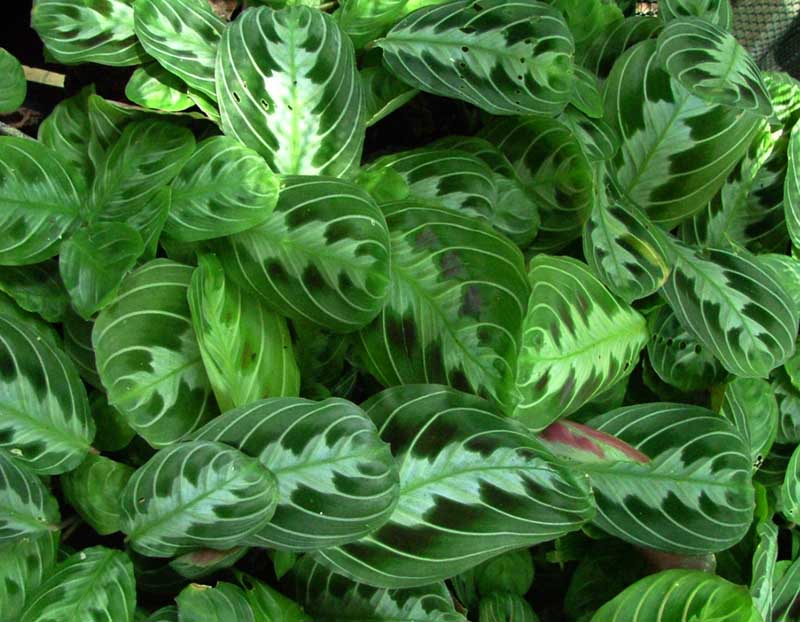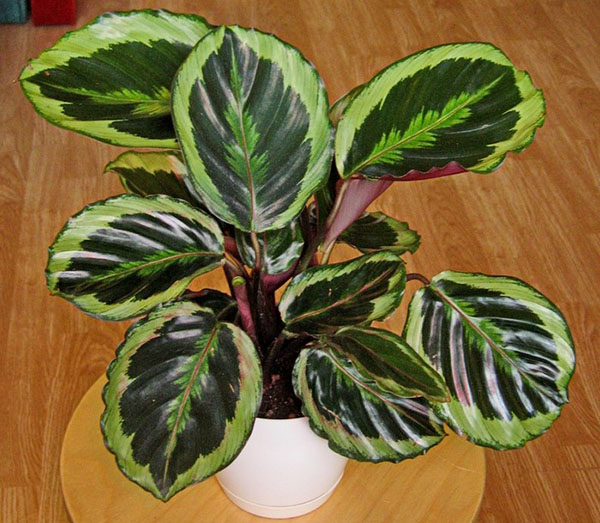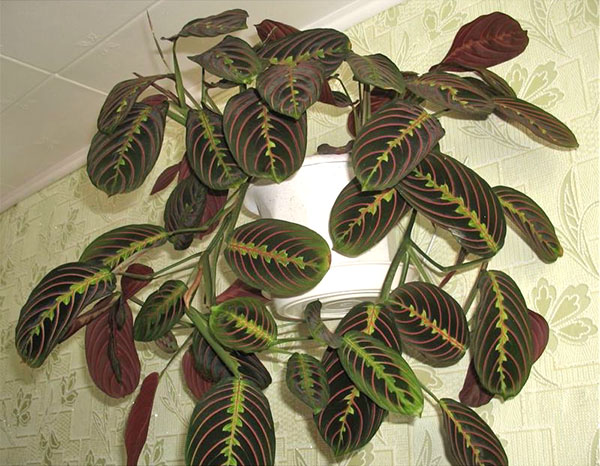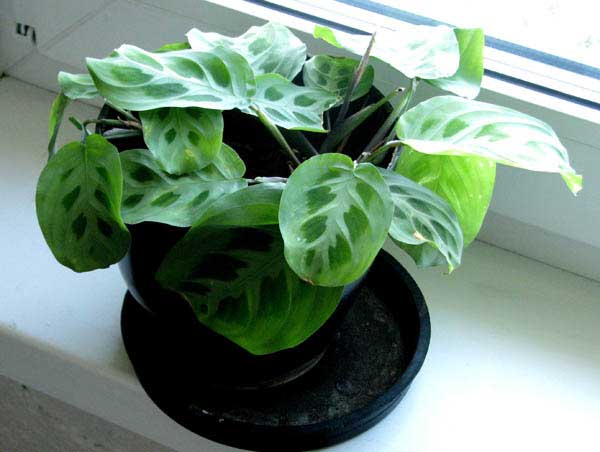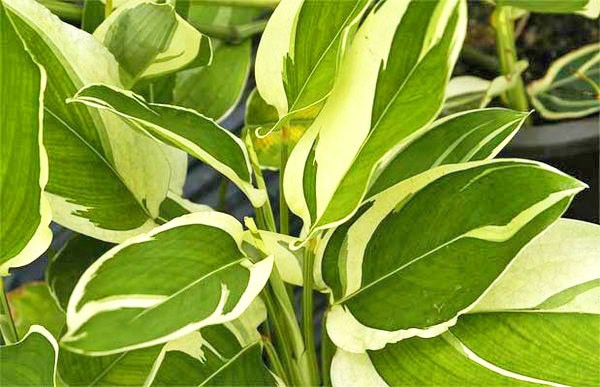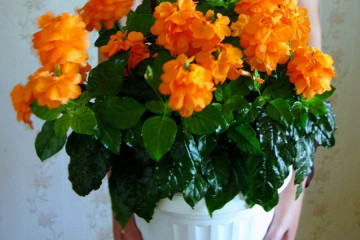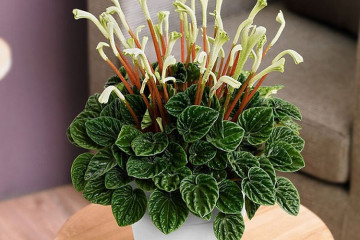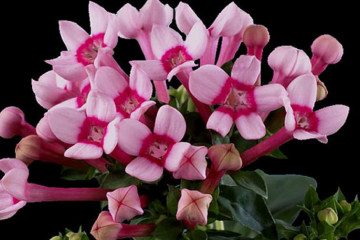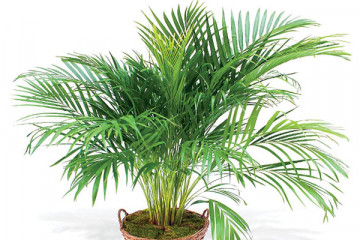Arrowroot - home care and reproduction
Content:
Arrowroot is an incredibly colored bush with large leaves. All flower growers love and admire her, she is not harmful and not capricious, if you provide the conditions of her homeland. The bushes are small and do not require a lot of light, so in any home there is a place for this exotic.
Arrowroot care at home
Arrowroot is widespread in South America, its bushes there can reach up to 1.5 meters in height, it bushes, relying on trees with its nodes. The leaves are large, spreading, absorbing a lot of moisture, which this plant loves very much. For the first time, the biologist and scientist Bartolomeo Marant gave a description of the plant, back in the 16th century. In honor of him, the plant acquired its name.
At home, the bush does not exceed 40 cm, the leaves are with an unusual and bright color. Flowering occurs at the end of summer and has no decorative appeal. The plant is also called prayer herb. This name comes from the unusual ability of the flower - in the morning and in the afternoon, its elastic leaves are arranged horizontally, with a lack of light, and this happens closer to night, the leaves become vertical and curl up into a tube. This ability is associated not only with lighting, but also with the preservation of moisture.
Arrowroot is suitable for novice florists, its care does not involve complex manipulations. All that is needed for favorable growth is moisture. But in order to provide it in sufficient quantity, several nuances must be taken into account.
Watering should be abundant and frequent. The soil should always be moist. The next watering is determined by the drying out of the first upper centimeters of the soil.
The ideal air humidity for arrowroot is 90%. Naturally, the climate in modern apartments does not allow creating such humidity on a permanent basis. Therefore, it is important to often spray a bright bush, and in the heat to arrange for him an additional source of moisture. To do this, you need to take a pallet for a large-diameter pot and pour expanded clay into it. You need to pour water so that it does not touch the pot.
With excess moisture, it can accumulate in the pot. Here is one of the problematic points of caring for arrowroot. With an incorrectly selected soil, the plant quickly dies - the roots rot, the leaves become covered with brown spots, become smaller and do not grow at all. To maintain constant moisture, but without stagnating it in the soil, you need:
- The correct pot. It should be wide and low.
- Drainage hole, preferably several.
- A good drainage layer, advice from experienced flower lovers - 1/3 of the pot should be a drainage layer.
- Breathable and water-conducting soil. If the ground for arrowroot is dense, it will accumulate water and provoke rotting of the delicate roots of the flower, become a breeding ground for fungi and parasites.
For a comfortable existence, it is also important:
- Temperature conditions. Summer time is not very successful for arrowroot, although this period falls on its active growth.If you provide it with a sufficient level of humidity, it is important not to raise the temperature above 25 degrees. Then it will be the conditions of her home - moderate heat and moisture. In winter, the optimum temperature is 18-20 degrees, but not near heating appliances. Dry air is detrimental to the plant.
- Top dressing. You can feed the plant all year round if there is no dormant period. From the beginning of spring to autumn, it should be in the form of alternating organic matter and mineral baits in a diluted form (twice or three times). Complementary foods should be fed every two weeks. In winter, if the plant continues to grow actively, you can feed it according to the summer scheme, but less often.
Before fertilizing, it is important to moisten the soil so that the roots do not get burned by the concentration of complementary foods.
Lighting plays an important role in the life of a flower. But here it is important to find a middle ground, since:
- Direct rays of the sun leave burns on the surface of the leaf plates.
- Excessive light discolors the color of the leaf. The flower loses its decorative effect and elasticity. The tips of the leaves can dry out if there is a lack of moisture in this light.
- Lack of light provokes the plant to stretch its lashes in length, rarely placing its leaves on them, which can become smaller for the same reason.
The plant feels comfortable on the east and even north window. If you choose between light and sufficient moisture, it is better to deprive the former. Without sufficient moisture, the plant will not be healthy.
How to care for arrowroot in winter
In winter, arrowroot can go to rest if the temperature is 7-10 degrees lower than in summer.
During sleep, its active growth slows down, but you should not stop watering and moisturizing. Although she is asleep, she still needs her food. Complementary food for the sleeping beauty is not needed. The light can also be reduced and carried deeper into the room, away from radiators and drafts.
The period of activity begins with the onset of spring. At this point, the arrowroot is transplanted, cut to maintain decorativeness or for reproduction. The fertilization period begins, lighting increases.
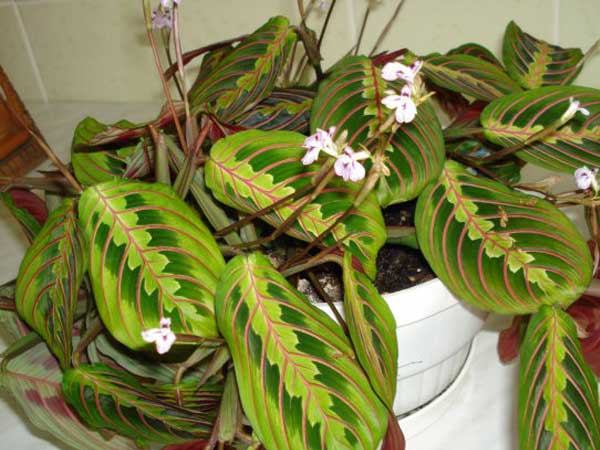
If by the end of summer the exotic pleased with its flowering, it means that the awakening was successful, and the plant was comfortable
Arrowroot breeding at home
Sometimes in a flower shop you can buy the seed of another plant consonant with indoor exotic. Growing from amaranth seeds occurs in summer cottages, and they are far from being related to arrowroot. Arrowroot will not seed at home. The plant successfully multiplies by root division and cuttings.
When transplanting, you can separate the bushes with a sharp knife and root the cuttings. It is important to divide so that there are enough roots for the further development of both plants. The flower takes root quickly, you can arrange a greenhouse for a young seedling for a faster and more successful rooting. Together with the pot, the plant is placed in a bag, leaving a window for fresh air. An optimal moisture balance will create ideal conditions for active growth of roots and shoots. With the appearance of the first leaves, the bag can be removed.
For propagation of arrowroot cuttings, shoots of at least 10 cm in length and with two internodes are needed. You need to cut off the shoot 1.5-2 cm below the node. Remove the lower leaves and put the cutting in an opaque container with water.Already after 10 days, the first roots appear on the shoots. According to the experience of breeders, rooting directly into the soil is not always successful.
There is a proven way to propagate arrowroot quickly and with a 100% guarantee of rooting. If the plant is more than a year old, aerial roots appear on the shoots near the nodes. Cuttings along with them will take root even faster and more successfully, since the root system has already begun to form and the forces were taken from the mother's supply.
Transfer
The root system of arrowroot does not grow too quickly, it braids the edges of the soil around the perimeter of the pot, collecting moisture and usefulness from fertilizers there. It is optimal to transplant a bright representative of Brazil once every two years during the awakening period - in the spring.
A regular plastic pot will do, wide and low, with good drainage holes. It should be two centimeters larger in diameter.
The drainage layer needs a thick and loose, moisture-permeable layer.
What soil is suitable for arrowroot
We get the necessary soil by mixing:
- 2 pieces of leafy land;
- 1 part peat;
- ½ part of sand.
If the bush stretches out after winter and has lost its decorative effect, flower lovers recommend completely cutting off all the shoots of the flower before transplanting. This will stimulate the growth of new shoots from the root, the development of buds on the remnants of cut shoots and the formation of a lush bush.
Possible growing problems
Referring to the exactingness of the flower, many growers refuse to acquire such a friend in their home. And in vain, all the problems in breeding this exotic are associated with the wrong conditions of its keeping. The first signals of poor health appear on the leaves, arrowroot begins to twist them.
Why do arrowroot leaves curl into a tube? There are several reasons for this behavior:
- drafts or low room temperature;
- lack of moisture in the soil or air;
- leaf pests;
- viral disease;
- high concentration fertilizer;
- the presence of worms or larvae from garden soil;
- touching a leaf of cold or hot window glass in winter or summer, respectively.
After finding curled leaves, it is important to examine the appearance of the entire plant and pay attention to the place where the flower is located and the conditions for its maintenance. Measures must be taken immediately, but the results will have to wait. For the prevention of disease and pests, you can use special preparations.
Why arrowroot leaf tips dry:
- the air temperature is too low;
- drafts;
- direct sunlight leaves burns and causes the tips to dry;
- low air humidity or insufficient watering;
- lack of nutrients in the soil, it's time to apply fertilizers;
- very rarely there is such a reaction to an increased concentration of lime in the soil.
Arrowroot, with painful symptoms, requires increased attention and daily examination to detect the causes of the disease and eliminate them as soon as possible.
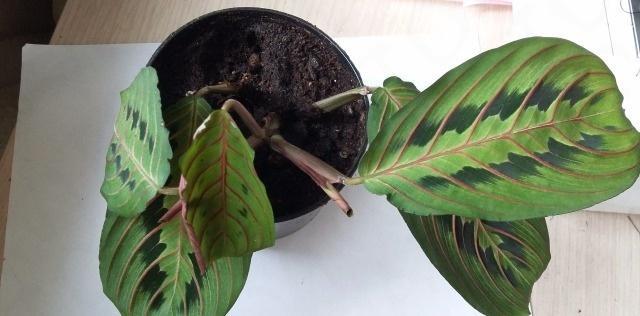
Arrowroot of the fascinator variety signals poor care by discoloration of its crimson veins on the leaves.
Blooming beauty - signs
Arrowroot does not bloom very often indoors.Its flowers are not particularly beautiful, and often flower growers simply cut off the peduncle shoots so that the flower does not waste its energy on them. Flowers of three petals are usually white or cream in color, not densely planted on the shoot.
According to popular beliefs, arrowroot is capable of:
- Improve the material condition of the family where the flower lives. If a flower decides to bloom, it portends an improvement in its material condition, making a big profit, or winning the lottery.
- Remove negativity in the family between spouses or children and parents. Normalizes the atmosphere of the house, bringing comfort and tranquility.
- Stabilize the condition of a sick person. Absorbing all the negativity and renewing the biofield, a flower placed at the head of a sick person contributes to a speedy recovery.
The plant is not demanding and is suitable even for novice growers. Compact, vibrant and exotic, it can bring a tropical touch to your home.
